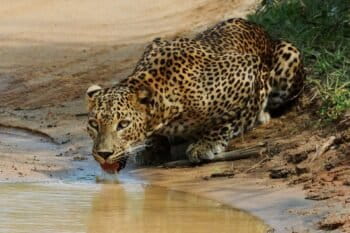Conservation group celebrates astonishing milestone after removing over 20 tons of invasive snakes: ‘We’re moving in the right direction’ – The Cool Down

Conservation Efforts Lead to Removal of Over 20 Tons of Invasive Burmese Pythons in Southwest Florida
Collaborative Initiative and Ecological Impact
A joint effort between the Conservancy of Southwest Florida and researchers at the University of Florida has successfully removed more than 20 tons of Burmese pythons from Southwest Florida. This initiative aligns with the United Nations Sustainable Development Goals (SDGs), particularly SDG 15: Life on Land, which emphasizes the protection, restoration, and promotion of sustainable use of terrestrial ecosystems.
Challenges Posed by Burmese Pythons
Burmese pythons are an aggressively invasive species in Florida’s Everglades, severely disrupting local ecosystems. Their status as generalist predators has led to dramatic declines in native wildlife populations:
- A 99.3% decline in raccoon populations
- A 98.9% decrease in opossums
- An 87.5% reduction in bobcats
- Near disappearance of marsh rabbits, cottontail rabbits, and foxes
These statistics, documented by the United States Geological Survey (USGS) in 2012, highlight the urgent need for invasive species management to preserve biodiversity, directly supporting SDG 15.
Impact on Native Plants and Ecosystem Balance
- The decline in herbivore populations threatens native plant species, although the full extent of this impact remains under study.
- Maintaining native plant diversity is crucial for ecosystem resilience and supports SDG 15’s objective of halting biodiversity loss.
Management Strategies and Community Involvement
Due to the Burmese python’s elusive nature and challenging Everglades terrain, Florida has adopted a containment strategy rather than eradication. This includes:
- Employing bounty hunters to control python populations
- Engaging local communities in invasive species monitoring and removal
These efforts contribute to SDG 17: Partnerships for the Goals, fostering collaboration among government, researchers, and the public.
Addressing Invasive Plant Species
In addition to animal invasives, over 755 invasive plant species in the U.S. threaten native flora by outcompeting them for nutrients. Homeowners are encouraged to:
- Upgrade to natural lawns that attract pollinators
- Support pollinator populations critical for food security and ecosystem health, aligning with SDG 2: Zero Hunger and SDG 15
- Reduce lawn maintenance costs and promote ecological harmony
Call to Action for Sustainable Ecosystem Management
While the battle against Burmese pythons continues, individuals can contribute to ecosystem balance by adopting sustainable landscaping practices and supporting conservation initiatives. These actions support multiple SDGs, including:
- SDG 13: Climate Action, through ecosystem preservation
- SDG 15: Life on Land, by protecting biodiversity
- SDG 17: Partnerships for the Goals, via community engagement
For ongoing updates and practical tips on contributing to environmental sustainability, individuals are encouraged to join relevant newsletters and access resources that promote positive environmental actions.
1. Sustainable Development Goals (SDGs) Addressed or Connected
- SDG 15: Life on Land
- The article focuses on the removal of invasive Burmese pythons in Florida, which directly impacts terrestrial ecosystems and biodiversity conservation.
- It highlights the decline of native wildlife populations such as raccoons, opossums, bobcats, marsh rabbits, cottontail rabbits, and foxes due to the invasive species.
- SDG 13: Climate Action
- Though not explicitly mentioned, the article’s emphasis on ecosystem balance and native plant preservation indirectly supports climate resilience and ecosystem health.
- SDG 12: Responsible Consumption and Production
- The promotion of natural lawns and sustainable gardening practices to reduce invasive plant species aligns with sustainable land use and resource management.
2. Specific Targets Under Those SDGs Identified
- SDG 15: Life on Land
- Target 15.8: By 2020, introduce measures to prevent the introduction and significantly reduce the impact of invasive alien species on land and water ecosystems.
- Target 15.5: Take urgent and significant action to reduce the degradation of natural habitats, halt the loss of biodiversity, and protect and prevent the extinction of threatened species.
- SDG 12: Responsible Consumption and Production
- Target 12.2: Achieve the sustainable management and efficient use of natural resources.
- SDG 13: Climate Action
- Target 13.1: Strengthen resilience and adaptive capacity to climate-related hazards and natural disasters in all countries (implied through ecosystem protection).
3. Indicators Mentioned or Implied to Measure Progress
- Population Decline of Native Species
- The article references USGS data showing a 99.3% decline in raccoon populations, 98.9% in opossums, and 87.5% in bobcats, which can serve as indicators of ecosystem health and invasive species impact.
- Amount of Invasive Species Removed
- Over 20 tons of Burmese pythons removed is a quantitative indicator of control efforts and progress towards local population suppression.
- Presence and Size Class of Scout Snakes
- The reduction in the number and size of scout snakes is used as a qualitative indicator of progress in controlling the invasive python population.
- Spread and Impact of Invasive Plant Species
- Though not quantified, the article implies monitoring invasive plant species spread and the health of native plants as indicators.
- Adoption of Sustainable Lawn Practices
- Promotion of natural lawns and pollinator-friendly plants can be tracked as indicators of community engagement and sustainable land management.
4. Table: SDGs, Targets and Indicators
| SDGs | Targets | Indicators |
|---|---|---|
| SDG 15: Life on Land |
|
|
| SDG 12: Responsible Consumption and Production |
|
|
| SDG 13: Climate Action |
|
|
Source: thecooldown.com

What is Your Reaction?
 Like
0
Like
0
 Dislike
0
Dislike
0
 Love
0
Love
0
 Funny
0
Funny
0
 Angry
0
Angry
0
 Sad
0
Sad
0
 Wow
0
Wow
0
















































































